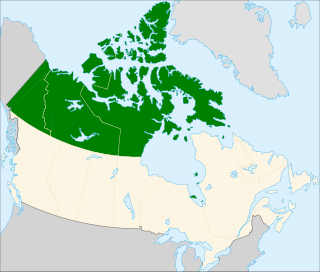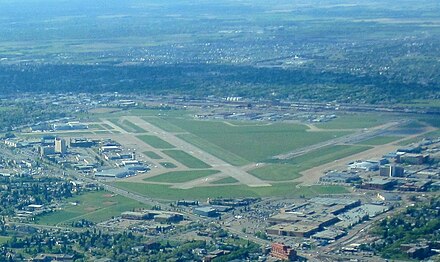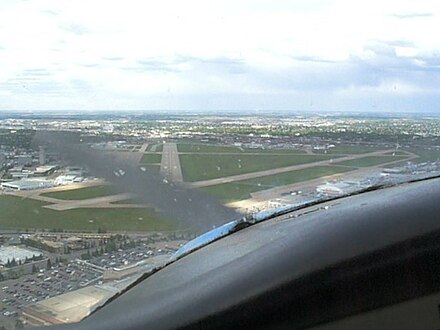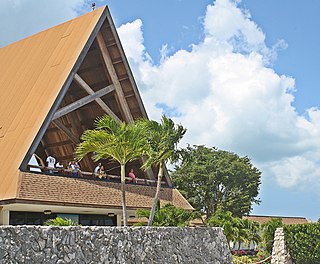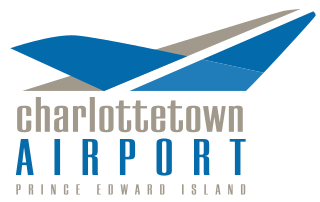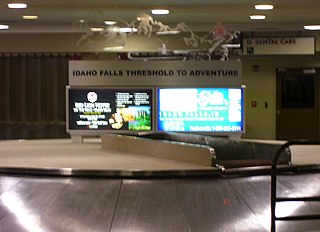It has been requested that the title of this article be changed to Edmonton City Centre Airport . Please see the relevant discussion on the discussion page. The page should not be moved unless the discussion is closed; summarizing the consensus achieved in support of the move. |
Edmonton City Centre Airport Blatchford Field | |||||||||||||||
|---|---|---|---|---|---|---|---|---|---|---|---|---|---|---|---|
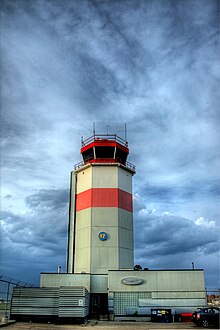 City Centre Airport control tower in 2010 | |||||||||||||||
| Summary | |||||||||||||||
| Airport type | Public | ||||||||||||||
| Owner | City of Edmonton | ||||||||||||||
| Operator | Edmonton Airports | ||||||||||||||
| Serves | Edmonton, Alberta, Canada | ||||||||||||||
| Opened | 1927 | ||||||||||||||
| Closed | November 30, 2013 | ||||||||||||||
| Time zone | MST (UTC−07:00) | ||||||||||||||
| • Summer (DST) | MDT (UTC−06:00) | ||||||||||||||
| Elevation AMSL | 2,202 ft / 671 m | ||||||||||||||
| Coordinates | 53°34′19″N113°31′10″W / 53.57194°N 113.51944°W Coordinates: 53°34′19″N113°31′10″W / 53.57194°N 113.51944°W | ||||||||||||||
| Map | |||||||||||||||
| Runways | |||||||||||||||
| |||||||||||||||
| Statistics (2012) | |||||||||||||||
| |||||||||||||||
Edmonton City Centre Airport (ECCA), also called Blatchford Field, was an airport located within the city of Edmonton, in Alberta, Canada.

An airport is an aerodrome with extended facilities, mostly for commercial air transport. Airports often have facilities to store and maintain aircraft, and a control tower. An airport consists of a landing area, which comprises an aerially accessible open space including at least one operationally active surface such as a runway for a plane to take off or a helipad, and often includes adjacent utility buildings such as control towers, hangars and terminals. Larger airports may have airport aprons, taxiway bridges, air traffic control centres, passenger facilities such as restaurants and lounges, and emergency services. In some countries, the US in particular, they also typically have one or more fixed-base operators, serving general aviation.

Edmonton is the capital city of the Canadian province of Alberta. Edmonton is on the North Saskatchewan River and is the centre of the Edmonton Metropolitan Region, which is surrounded by Alberta's central region. The city anchors the north end of what Statistics Canada defines as the "Calgary–Edmonton Corridor".

Alberta is a province of Canada. With an estimated population of 4,067,175 as of 2016 census, it is Canada's fourth most populous province and the most populous of Canada's three prairie provinces. Its area is about 660,000 square kilometres (250,000 sq mi). Alberta and its neighbour Saskatchewan were districts of the Northwest Territories until they were established as provinces on September 1, 1905. The premier is Jason Kenney as of April 30, 2019.
Contents
- Early history
- RCAF Station Edmonton
- Weather
- Scheduled passenger service
- 1950s and 1960s
- 1970s and 1980s
- 1990s
- Final years (2000–2013)
- Obsolescence and closure
- Debate
- Closure
- Blatchford community 2
- Airport facilities (historical)
- Airfield and runways
- Facilities and amenities
- Accidents and incidents
- See also
- References
- External links
It was bordered by Yellowhead Trail to the north, Kingsway to the south, 121 Street to the west, and the Northern Alberta Institute of Technology (NAIT) and Jefferson armouries to the east. It encompassed approximately 144 acres (58 ha) of land just north of the city centre of Edmonton.

Alberta Provincial Highway No. 16, commonly referred to as Highway 16, is a major east–west highway in central Alberta, Canada, connecting Jasper to Lloydminster via Edmonton. It forms a portion of the Yellowhead Highway, a major interprovincial route of the Trans-Canada Highway system that stretches from Masset, British Columbia to Portage la Prairie, Manitoba, near Winnipeg. Highway 16 spans approximately 634 km (394 mi) from Alberta's border with British Columbia in the west to its border with Saskatchewan in the east. As of 2010, all but less than 96 km (60 mi) of the route was divided, with a minimum of two lanes in each direction. It is designated a core route in Canada's National Highway System.
The Northern Alberta Institute of Technology (NAIT) is a polytechnic and applied sciences institute in Edmonton, Alberta, Canada. NAIT provides careers programs in applied research, technical training, applied education, and learning designed to meet the demands of Alberta's technical and knowledge-based industries. NAIT offers approximately 120 credit programs leading to degrees, applied degrees, diplomas and certificates. As of 2018, there are approximately 16,000 students in credit programs 12,000 apprentices registered in apprenticeship training, 14,500 students enrolled in non-credit courses, and more than 20,000 registrants for customized corporate based training. NAIT also attracts international students from 94 countries. NAIT is similar to an Institute of technology or university of applied sciences as termed in other jurisdictions. The campus newspaper, the NAIT Nugget, is a member of the Canadian University Press (CUP).
The airport was originally called Blatchford Field, named for former mayor Kenneth Alexander Blatchford. It later was known as the Edmonton Municipal Airport, then as Edmonton Industrial Airport, [4] and then Edmonton City Centre Airport (ECCA), finally ending as Blatchford Field at Edmonton City Centre Airport. Over the years, the three letter code "YXD" ( IATA : YXD, ICAO : CYXD) continued to be used for the airport by all of the airlines serving the airfield.

Kenneth Alexander Blatchford was a Canadian politician who served as both mayor of Edmonton, Alberta and a member of the House of Commons of Canada.
An IATA airport code, also known as an IATA location identifier, IATA station code or simply a location identifier, is a three-letter code designating many airports and metropolitan areas around the world, defined by the International Air Transport Association (IATA). The characters prominently displayed on baggage tags attached at airport check-in desks are an example of a way these codes are used.

The ICAOairport code or location indicator is a four-letter code designating aerodromes around the world. These codes, as defined by the International Civil Aviation Organization and published in ICAO Document 7910: Location Indicators, are used by air traffic control and airline operations such as flight planning.
The airport was closed in November 2013, and as of 2018 [update] , the land is being redeveloped by the City of Edmonton as a planned community called Blatchford.


